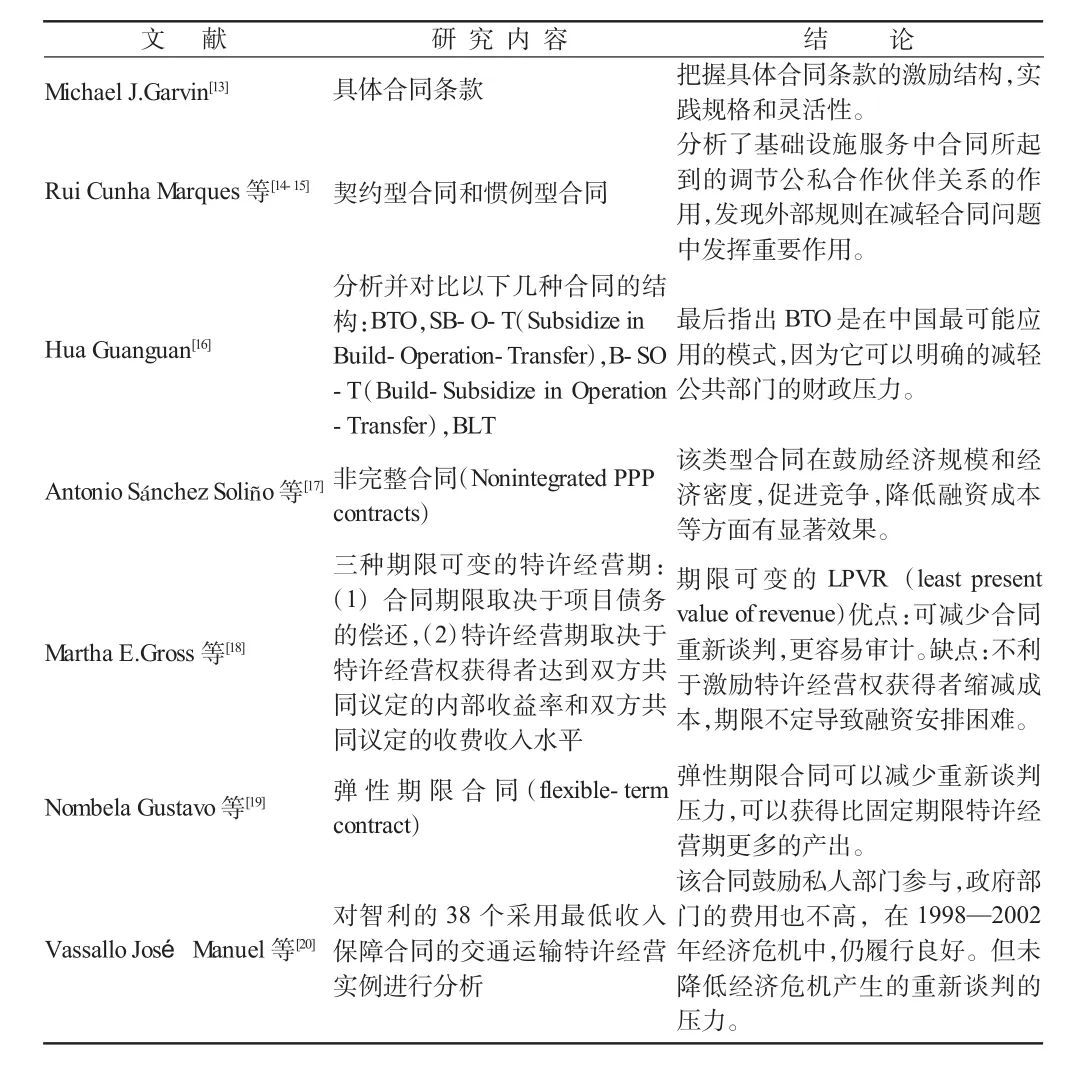国外PPP合同研究现状梳理及趋势分析
2013-09-03李丽红黄昌铁
李丽红,张 舒,黄昌铁
(沈阳建筑大学管理学院,辽宁沈阳110168)
PPP(Public-Private Partnership),即公私合作伙伴关系,鼓励私营企业与政府合作,参与公共基础设施建设。通过该模式,政府可以拓宽融资渠道,减轻财政压力;私营企业可以增加投资机会,取得合理回报;对社会而言,可以提高资金使用效率,增快公共基础设施供给速度,提升公共项目建设管理水平,满足社会公众需求,提高社会福利。
PPP模式中合同具有重要地位。政府和私营企业的投资比例及时机、风险分担、利益分配、重新谈判等问题都将在合同中得到约定,因此对合同的研究具有重要意义。
一、相关概念的界定
(一)PPP概念的界定
目前关于PPP尚未有统一的概念,欧盟委员会[1]、加拿大PPP国家委员会[2]、美国PPP国家委员会[3]和联合国欧洲经济委员会[4]等组织对PPP均有论述,这些论述对PPP的主体和目的认识一致,对实质的理解略有不同,有的侧重于合同,有的侧重于关系。由于合同具有不完全性,只能部分体现合作伙伴关系,因此,PPP是公共部门和私人部门为了提供公共设施或服务而建立的以合同为载体的合作伙伴关系。
(二)PPP合同主体的界定
PPP合同可分为PPP合同(特许经营合同)和PPP外围合同(股东协议、项目融资合同、建设合同、保险合同以及运营协议和维修协议)[5]。本文仅研究PPP合同,故PPP合同主体是指公共部门和私人部门。
二、近三年PPP合同研究现状的梳理
从PPP合同的过程和内容两个维度对近三年国外文献进行梳理,其中合同过程包括设立、履行、终止,合同内容包括合同种类、投资比例及时机、风险分担、利益分配。
(一)PPP合同过程
1.合同设立。Siemonsma Hidde认为,私人企业若在PPP项目的早期介入,取得PPP合同,则明显有助于项目的成功,尤其是对特别复杂项目,与候选人的早期对话可降低预期交易成本,提高预期合同价值,进而提高整个项目的价值。[6]在我国,根据《中华人民共和国国务院关于投资体制改革的决定》(国发[2004]20号)规定,PPP项目大多需要使用政府投资或者属于《政府核准的投资项目目录》,需要审批或者核准,这些程序增加了私营企业早期介入PPP项目的难度和风险。
有文献对公私双方谈判应考虑的内容及需加强的方面进行了研究。Jicai Liu等应用实物期权模型,提出谈判余地带(a negotiation band)的概念,据此扩大公私双方讨价还价的范围。[7]但PPP合同期限一般长达十几年甚至几十年,期间的政策导向、市场环境、技术水平等变化大,不确定因素多,双方均需制定详细的谈判策略,该领域的研究还有待加强。
2.合同履行。契约不完备性及合同履行期限长,导致PPP项目合同重新谈判(renegotiation)普遍存在,因此,对双方在履约过程中重新谈判的研究尤为必要。就笔者所能查到的文献来看,现有研究对重新谈判均持否定态度,其研究集中在如何避免、限制重新谈判。
重新谈判可以分为两种,需要区别对待:(1)对于私营公司“中标靠低价,盈利靠索赔”式的重新谈判,要坚决避免、限制、甚至惩罚,文献中所指的重新谈判均属此类;(2)合理的重新谈判要尊重,考虑到PPP特许经营期长,利益相关方多,存在政治、建造、运营、收益、财经和法律等方面的风险,环境变化大,不确定性因素多,存在一些合理重新谈判的诉求,若完全否定重新谈判可能直接导致某一参与方因利益诉求得不到合理满足或损失过大而退出,给项目造成重大损失。

表1 近三年关于PPP重新谈判的主要文献的总结
因此,合理的重新谈判是一种沟通渠道,是一种争端解决机制。赋予私营企业合理重新谈判的权利,允许必要的合同变更,对项目的建设是有利的。如何通过重新谈判调整公私双方权责利关系,具有重要现实意义,尚未发现此领域的相关文献。
3.合同终止。合同终止即研究公私双方在哪些情况下可以提前终止协议并解除合作伙伴关系,对近三年国外相关文献进行梳理,未发现专门研究这两个方面的文献。
(二)PPP合同内容
1.类型选择。由文献可知,不同类型的合同在减轻公共部门财政压力、促进竞争、降低融资成本、减少不合理重新谈判、激励私人部门和抵抗经济危机等方面有着重要影响。因此,对于不同行业、不同项目,有必要进一步研究如何选择就合同类型的问题。
2.投资比例及时机。Ryuta Takashima[21]利用实物期权,研究在公私双方确定投资时机的问题。Deepak K.Sharma等[22]应用线性规划和概率论提出一个负债和权益投资确定模型,借此公共部门可评估PPP项目私有股权所占范围,确定目标股权结构。
投资比例涉及股权结构,投资时机涉及投资成本(资金时间价值),两者直接影响公私双方的经济利益,是合同谈判的重要内容,应在合同中有明确的约定。但对该问题的研究很少,应该综合考虑公私双方利益,提出研究方法,确定双方合理的出资比例和时机选择的取值范围。

表2 近三年关于PPP合同类型的相关文献的总结
3.风险分担。PPP风险分担研究文献数量较多,数学模型应用广泛,内容具体深入,风险分担在理论上的研究已较为完善。数学模型研究比较典型的文献有Yongjian Ke等[23-24]采用问卷调查、德尔菲法;Albert P.C.Chan[25],Chohra Mohamed[26],S.Ping Ho[27]采用了实证分析方法;Esther Cheung[28]采用文献综述方法;Jie L[29],Yelin Xu[30]应用了模糊层次分析法和模糊综合评价模型;K.C.Iyer[31]应用结构模型解析法;Rui Cunha Marques[32]等采用理论分析法;Xiao-Hua Jin等[33]则采用了人工神经网络法。但合同文本层面的研究较为欠缺。
4.利益分配。利益分配受多方影响:公共产品收费费率结构、收益期限(特许经营期长短)、以及两者的综合作用,激励机制,股权结构,风险影响,政府和私营公司的议价能力等。此外,PPP项目产品的定价机制以及PPP项目的收益在公私双方之间如何分配也有待研究。
三、PPP合同研究的现状评析
将上述合同的过程维和内容维归纳在一起,就形成了PPP合同研究霍尔矩阵,如表4所示。从过程维来看,研究集中于设立阶段,履行阶段近3年文献研究数量逐渐增加;从内容维来看,PPP合同的利益分配和风险分担文献较多,重新谈判逐渐成为研究热点。

表3 近三年关于PPP利益分配主要文献的总结

表4 PPP合同研究霍尔矩阵
四、研究趋势
1.完善对合同全过程的研究。研究热点主要有:在合同设立阶段,公私双方在什么情况下,可以提前终止合同;在合同履行阶段,对合理的重新谈判,应该怎样进行,以适应变化,调整公私双方的利益关系;在项目完成之后,从哪些方面,怎样进行合同后评价。
2.重要领域的深入研究。合同谈判策略的研究;政府采取哪些措施鼓励私营企业尽早介入;对不合理的重新谈判怎样避免、限制、惩罚;根据不同行业、不同项目,怎样选择合同类型;风险分担理论向合同文本层面应用;研究公私双方确定出资比例及时机的依据和方法;建立合理的公共产品定价机制和利益分配体系。
3.形成PPP合同示范文本。在上述研究较为成熟之后可以考虑建立PPP合同示范文本,对PPP合同主要内容进行规范,明确公私双方的权利义务。
[1]The European Commission.Guidance for Successful PPP.2003.
[2]The Canadian Council for Public-Private Partnerships.Definitions[EB/OL].[2012-04-20].http://www.pppcouncil.ca/resources/about-ppp/definitions.html.
[3]The National Council for Public-Private Partnerships.Public-private partnerships defined[EB/OL].[2012-04-20].http://www.ncppp.org/howpart/index.shtml#define.
[4]United Nations Economic Commission for Europe.Guidebook on PromotingGood Governance in Public-Private Partnerships.2008.
[5]Andrade Alexandre,Raquel André Santos.Public-private partnership in Portugal-the legal structure of the public-private partnership contract and the peripheral contracts[J].European Public Private Partnership LawReview,2010(1):46-53.
[6]Siemonsma Hidde,Van Nus Wouter,Uyttendaele Patrick.Awarding of Port PPP contracts:the added value of a competitive dialogue procedure[J].Maritime Policy&Management,2012(1):63-78.
[7]Jicai Liu,Charles Y.J.Cheah.Real option application in PPP/PFI project negotiation[J].Construction Management and Economics,2009(4):331-342.
[8]Engel Eduardo,Ronald Fischer,Alexander Galetovic.Soft budgets and renegotiations in public-private partnerships[M].Massachusetts:Cambridge,2009.
[9]Satish D,Shah Pragya.A studyof public private partnership models[J].ICFAI Journal of Infrastructure,2009(1):23-37.
[10]Bi Xing,Wang Hong.The control of moral hazard in PPP project renegotiation[J].2011 IEEE 18th International Conference on Industrial Engineering and EngineeringManagement,2011:232-236.
[11]Antonio Estache,Jose-Luis Guasch,Atsushi Iimi,Lourdes Trujillo.Multidimensionality and renegotiation:Evidence from transport-sector public-privatepartnership transactions in Latin America[J].ReviewofIndustrial Organization,2009(35):41-71.
[12]S.PingHo,Chun Wei Tsui.The transaction costs ofpublic-private partnerships:Implications on PPP governance design[J].The Lead 2009 Conference,2009.
[13]Michael J.Garvin.Governance ofPPP projects through contract provisions[J].Conference ofLeadership and Management ofConstruction,2009.
[14]Rui Cunha Marques,Sanford Berg.Revisiting the strengths and limitations of regulatory contracts in infrastructure industries[J].Journal of Infrastructure Systems,2010(4):334-342.
[15]Rui Cunha Marques,Sanford Berg.Public-private partnership contracts:a tale of twocities with different contractual arrangements[J].Public Administration,2011(4):1585-1603.
[16]Hua Guanguan.Studyon PPP contract-models for urban rail transit(URT)projects in China[J].Communications in Computer and Information Science,2011:516-523.
[17]AntonioSánchezSoliño,José M.Vassallo.Usingpublic-private partnerships toexpand subways:Madrid-Barajas international airport case study[J].Journal ofManagement in Engineering,2009(1):21-28.
[18]Martha E.Gross,Michael J.Garvin.Approaches for structuringconcession lengths and toll rates for transportation infrastructure PPPs[J].Buildinga Sustainable Future-Proceedings ofthe 2009 Construction Research Congress,2009:191-200.
[19]Nombela Gustavo,de Rus Ginés.Flexible-termcontracts for road franchising[J].Transportation Research Part A:Policyand Practice,2004,38(3):163-179.
[20]VassalloJosé Manuel,SoliñoAntonioSánchez.Minimumincome guarantee in transportation infrastructure concessions in Chile[J].Transportation Research Record,2006:15-22.
[21]Ryuta Takashima,KyokoYagi,Hiroshi Takamori.Government guarantees and risk sharingin public-private partnerships[J].Reviewof Financial Economics,2010(2):78-83.
[22]Deepak K.Sharma,Qingbin Cui,Lijian Chen,JayK.Lindly.Balancingprivate and public interests in public-private partnership contracts through optimization ofequitycapital structure[J].Transportation Research Record:Journal ofthe Transportation Research Board,2010(8):60-66.
[23]Yongjian Ke,ShouQing Wang,Albert P.C.Chan.Risk allocation in public-private partnership infrastructure projects:Comparative study[J].Journal of Infrastructure Systems,2010(4):343-351.
[24]Yongjian Ke,ShouQing Wang,Albert P.C.Chan,Esther Cheung.Understanding the risks in China's PPP projects:ranking of their probability and consequence[J].EngineeringConstruction&Architectural Management,2011(5):481-496.
[25]Albert P.C.Chan,John F.Y.Yeung,Calvin C.P.Yu,Shou Qing Wang,Yongjian Ke.Empirical study of risk assessment and allocation of public-private partnership projects in China[J].Journal ofManagement in Engineering,2011(3):136-148.
[26]Chohra Mohamed,Mu Shiyu,ChengHu.Risks and newtransformations ofPPP contracts[J].Journal ofSoutheast University,2011(4):458-462.
[27]S.Ping Ho,Chun Wei Tsui.When are public-private partnerships not an appropriate governance structure?Case study evidence[J].Construction Research Congress 2010:Innovation for ReshapingConstruction Practice,2010:817-826.
[28]Esther Cheung,Albert P.C.Chan.Risk Factors of Public-Private Partnership Projects in China:Comparison between the Water,Power,and Transportation Sectors[J].Journal ofUrban Planning&Development,2011(4):409-415.
[29]Jie Li,Patrick X.W.Zou.FuzzyAHP-Based risk assessment methodologyfor PPP projects[J].Journal of Construction Engineering&Management,2011(12):1205-1209.
[30]Yelin Xu,John F.Y.Yeung,Albert P.C.Chan,Daniel W.M.Chan,Shou Qing Wang,Yongjian Ke.Developing a risk assessment model for PPP projects in China-Afuzzysynthetic evaluation approach[J].Automation in Construction,2010(7):929-943.
[31]K.C.Iyer,Mohammed Sagheer.Hierarchical structuring of PPP risks using interpretative structural modeling[J].Journal of Construction Engineering&Management,2010(2):151-159.
[32]Rui Cunha Marques,Sanford Berg.Risks,contracts,and private-sector participation in infrastructure[J].Journal ofConstruction Engineeringand Management,2011(11):925-932.
[33]Xiao-Hua Jin,Guomin Zhang.Modelling optimal risk allocation in PPP projects using artificial neural networks[J].International Journal of Project Management,2011(5):591-603.
[34]Bo Song,Fei Xu,Ying Zhou.Analysis on supervision mechanism of government in PPP contract[J].2011 2nd International Conference on Artificial Intelligence,Management Science and Electronic Commerce,2011:6549-6552.
[35]S.Thomas Ng,Jingzhu Xie,Mohan M.Kumaraswamy.Simulating the effect of risks on equity return for concession-based public-private partnership projects[J].EngineeringConstruction&Architectural Management,2010(4):352-368.
[36]Yan Qin Zhang,Qi Xun Fu.Game analysis of income distribution between public and private parties in the PPP construction pattern of the security housing[J].Advanced Materials Research,2012:3885-3888.
